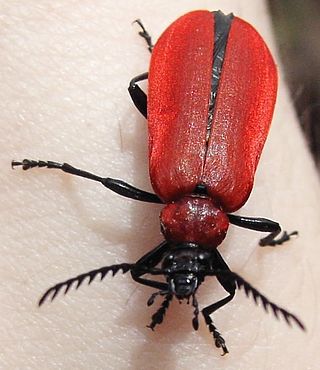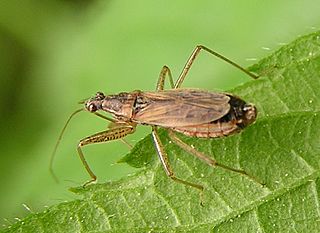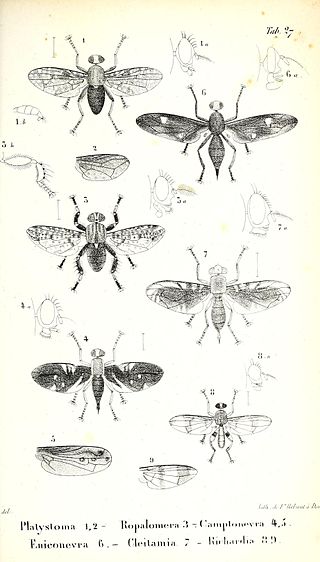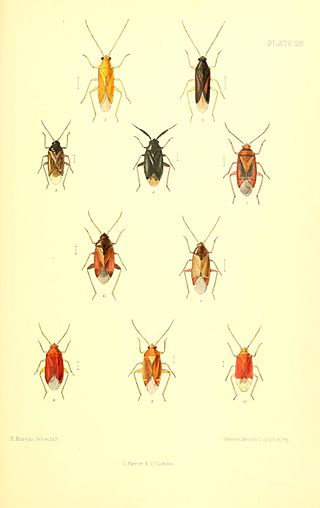
Sphaerites is a genus of beetles, the only genus in the family Sphaeritidae, sometimes called the false clown beetles. There are five known species, which are widespread in temperate areas of the Northern Hemisphere, found in forested or upland areas.

Fire-coloured beetles is the common name for members of the tenebrionoid family Pyrochroidae. The family is found worldwide, and is most diverse at temperate latitudes. Adults measure 2–20 millimetres (0.079–0.787 in); larvae reach 35 millimetres (1.4 in). Larvae of Pyrochroinae are found associated with the bark of dead trees. They are probably mostly fungivorous, although they may become cannibalistic if too crowded.

Enicocephalidae, also called unique-headed bugs and gnat bugs, are a family of around 300 species of the suborder Heteroptera. They are typically 4 mm (0.16 in) long, and found throughout the world. They have an elongated head, constricted in places, hence their head is 'unique'.

The insect family Nabidae contains the damsel bugs. There are over 500 species in 20 genera. They are soft-bodied, elongate, winged terrestrial predators. Many damsel bugs catch and hold prey with their forelegs, similar to mantids. They are considered helpful species in agriculture because of their predation on many types of crop pests.

The Ochteridae comprise a small family of insects. Eight genera with about 80 species have been described. They occur worldwide along the shore of various types of water and the greatest diversity is in tropical regions. They are "true bugs", being members of the order Hemiptera, and are in the suborder Heteroptera. Ochteridae commonly are known as the velvety shore bugs. They resemble the Saldidae shore bugs and have lengths ranging from 4.5 to 9 mm (0.18–0.35 in).

Myopsocidae is a family of mouse-like barklice, belonging to the infraorder Psocetae of the order Psocodea. This family is closely related to Psocidae, with which it shares similar wing-venation, but from which it is distinguished by three-segmented tarsi.

Peripsocidae is a family of Psocodea belonging to the suborder Psocomorpha. Members of the family are characterised by their absence of an areola postica in their wings. Many of the recently described genera are closely allied to Peripsocus. The family includes more than 300 species.

Lachesillidae is a family of Psocodea belonging to the suborder Psocomorpha. Members of the family are characterized by a rounded, free areola postica in their wings. Males have diverse sclerotized genitalic structures. The family includes more than 400 species, most of them in the genus Lachesilla.

Lachesilla is the main genus in the psocopteran family Lachesillidae. There are at least 310 described species in Lachesilla. Frequent species in the Northern hemisphere include Lachesilla quercus and Lachesilla pedicularia. Some species are localized: Lachesilla merzi has been collected only once in Spain and Lachesilla rossica, apart from the original specimens that were found in southern Russia, is only known from the Valley of the Allondon river, near Geneva, Switzerland.

The Ropalomeridae are a family of acalyptrate flies.

Elaphropus is a genus of ground beetles in the family Carabidae. There are at least 370 described species in Elaphropus.

Sciocoris is a genus of shield bugs belonging to the family Pentatomidae, subfamily Pentatominae. The genus was erected by Carl Fredrik Fallén in 1829.

Perillus is a genus of predatory stink bugs in the family Pentatomidae. There are about seven described species in Perillus.

Xylocoris is a genus of bugs in the monotypic tribe Xylocorini of the family Anthocoridae. There are approximately 50 described species in Xylocoris worldwide. Nearly 30 species occur in the Palaearctic Region, 10 are known from the Nearctic Region, and 6 from the Oriental Region. They occur in various habitats, often found under plant litter and under tree bark where they feed on small arthropods. Certain species inhabit stored food facilities.
Oeciacus vicarius, known generally as the American swallow bug or cliff swallow bug, is a species of bed bug in the family Cimicidae. It is found in North America. The bug is a blood-feeding ectoparasite of the colonially nesting American cliff swallow and vector of Buggy Creek Virus.

Xylocoris galactinus is a species of bugs in the family Anthocoridae. It is found in Europe & Northern Asia, North America, and Oceania.

Psallus variabilis is a species of plant bug in the family Miridae. It is found in the Palearctic and as an adventive species in North America. It feeds on the sap of a variety of forest trees including Quercus, plum and crab apple trees and on rose, raspberry and cranberry.

Narnia is a genus of leaf-footed bugs in the family Coreidae. There are six described species in Narnia.
Xylocoris flavipes, the warehouse pirate bug, is a species of bugs in the family Anthocoridae. It is found in Africa, Australia, Europe and Northern Asia, North America, South America, and Southern Asia.















